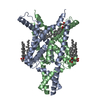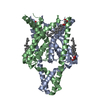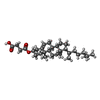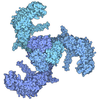[English] 日本語
 Yorodumi
Yorodumi- EMDB-51158: Structure of the human two pore domain potassium ion channel TASK... -
+ Open data
Open data
- Basic information
Basic information
| Entry |  | ||||||||||||
|---|---|---|---|---|---|---|---|---|---|---|---|---|---|
| Title | Structure of the human two pore domain potassium ion channel TASK-3 (K2P9.1) | ||||||||||||
 Map data Map data | B factor sharpened map | ||||||||||||
 Sample Sample |
| ||||||||||||
 Keywords Keywords | K2P / membrane protein / potassium channel / ion channel | ||||||||||||
| Function / homology |  Function and homology information Function and homology informationnegative regulation of aldosterone secretion / regulation of action potential firing rate / TWIK-releated acid-sensitive K+ channel (TASK) / Phase 4 - resting membrane potential / potassium ion leak channel activity / regulation of resting membrane potential / cellular response to acidic pH / outward rectifier potassium channel activity / sodium channel activity / potassium ion import across plasma membrane ...negative regulation of aldosterone secretion / regulation of action potential firing rate / TWIK-releated acid-sensitive K+ channel (TASK) / Phase 4 - resting membrane potential / potassium ion leak channel activity / regulation of resting membrane potential / cellular response to acidic pH / outward rectifier potassium channel activity / sodium channel activity / potassium ion import across plasma membrane / potassium channel activity / visual perception / potassium ion transport / synaptic vesicle / mitochondrial inner membrane / protein heterodimerization activity / dendrite / metal ion binding / identical protein binding / plasma membrane Similarity search - Function | ||||||||||||
| Biological species |  Homo sapiens (human) Homo sapiens (human) | ||||||||||||
| Method | single particle reconstruction / cryo EM / Resolution: 3.32 Å | ||||||||||||
 Authors Authors | Hall PH / Rodstrom KEJ / Tucker SJ | ||||||||||||
| Funding support |  United Kingdom, 3 items United Kingdom, 3 items
| ||||||||||||
 Citation Citation |  Journal: Structure / Year: 2025 Journal: Structure / Year: 2025Title: Structures of TASK-1 and TASK-3 K2P channels provide insight into their gating and dysfunction in disease. Authors: Peter Rory Hall / Thibault Jouen-Tachoire / Marcus Schewe / Peter Proks / Thomas Baukrowitz / Elisabeth P Carpenter / Simon Newstead / Karin E J Rödström / Stephen J Tucker /   Abstract: TASK-1 and TASK-3 are pH-sensitive two-pore domain (K2P/KCNK) K channels. Their functional roles make them promising targets for treatment of multiple disorders including sleep apnea, pain, and ...TASK-1 and TASK-3 are pH-sensitive two-pore domain (K2P/KCNK) K channels. Their functional roles make them promising targets for treatment of multiple disorders including sleep apnea, pain, and atrial fibrillation. Mutations in these channels are also associated with neurodevelopmental and hypertensive disorders. A previous crystal structure of TASK-1 revealed a lower "X-gate" as a hotspot for missense gain-of-function (GoF) mutations associated with DDSA (developmental delay with sleep apnea). However, the mechanisms of gating in TASK channels are still not fully understood. Here, we resolve structures for both human TASK-1 and TASK-3 by cryoelectron microscopy (cryo-EM), as well as a recurrent TASK-3 variant (G236R) associated with KCNK9 imprinting syndrome (KIS) (formerly known as Birk-Barel syndrome). Combined with functional studies of the X-gating mechanism, we provide evidence for how a highly conserved gating mechanism becomes defective in disease, and also provide further insight into the pathway of conformational changes that underlie the pH-dependent inhibition of TASK channel activity. | ||||||||||||
| History |
|
- Structure visualization
Structure visualization
| Supplemental images |
|---|
- Downloads & links
Downloads & links
-EMDB archive
| Map data |  emd_51158.map.gz emd_51158.map.gz | 32.8 MB |  EMDB map data format EMDB map data format | |
|---|---|---|---|---|
| Header (meta data) |  emd-51158-v30.xml emd-51158-v30.xml emd-51158.xml emd-51158.xml | 18.4 KB 18.4 KB | Display Display |  EMDB header EMDB header |
| FSC (resolution estimation) |  emd_51158_fsc.xml emd_51158_fsc.xml | 8.4 KB | Display |  FSC data file FSC data file |
| Images |  emd_51158.png emd_51158.png | 115 KB | ||
| Masks |  emd_51158_msk_1.map emd_51158_msk_1.map emd_51158_msk_2.map emd_51158_msk_2.map | 64 MB 64 MB |  Mask map Mask map | |
| Filedesc metadata |  emd-51158.cif.gz emd-51158.cif.gz | 6.3 KB | ||
| Others |  emd_51158_half_map_1.map.gz emd_51158_half_map_1.map.gz emd_51158_half_map_2.map.gz emd_51158_half_map_2.map.gz | 59.2 MB 59.2 MB | ||
| Archive directory |  http://ftp.pdbj.org/pub/emdb/structures/EMD-51158 http://ftp.pdbj.org/pub/emdb/structures/EMD-51158 ftp://ftp.pdbj.org/pub/emdb/structures/EMD-51158 ftp://ftp.pdbj.org/pub/emdb/structures/EMD-51158 | HTTPS FTP |
-Validation report
| Summary document |  emd_51158_validation.pdf.gz emd_51158_validation.pdf.gz | 865 KB | Display |  EMDB validaton report EMDB validaton report |
|---|---|---|---|---|
| Full document |  emd_51158_full_validation.pdf.gz emd_51158_full_validation.pdf.gz | 864.6 KB | Display | |
| Data in XML |  emd_51158_validation.xml.gz emd_51158_validation.xml.gz | 16.4 KB | Display | |
| Data in CIF |  emd_51158_validation.cif.gz emd_51158_validation.cif.gz | 21.3 KB | Display | |
| Arichive directory |  https://ftp.pdbj.org/pub/emdb/validation_reports/EMD-51158 https://ftp.pdbj.org/pub/emdb/validation_reports/EMD-51158 ftp://ftp.pdbj.org/pub/emdb/validation_reports/EMD-51158 ftp://ftp.pdbj.org/pub/emdb/validation_reports/EMD-51158 | HTTPS FTP |
-Related structure data
| Related structure data |  9g9vMC  9g9wC  9g9xC M: atomic model generated by this map C: citing same article ( |
|---|---|
| Similar structure data | Similarity search - Function & homology  F&H Search F&H Search |
- Links
Links
| EMDB pages |  EMDB (EBI/PDBe) / EMDB (EBI/PDBe) /  EMDataResource EMDataResource |
|---|---|
| Related items in Molecule of the Month |
- Map
Map
| File |  Download / File: emd_51158.map.gz / Format: CCP4 / Size: 64 MB / Type: IMAGE STORED AS FLOATING POINT NUMBER (4 BYTES) Download / File: emd_51158.map.gz / Format: CCP4 / Size: 64 MB / Type: IMAGE STORED AS FLOATING POINT NUMBER (4 BYTES) | ||||||||||||||||||||||||||||||||||||
|---|---|---|---|---|---|---|---|---|---|---|---|---|---|---|---|---|---|---|---|---|---|---|---|---|---|---|---|---|---|---|---|---|---|---|---|---|---|
| Annotation | B factor sharpened map | ||||||||||||||||||||||||||||||||||||
| Projections & slices | Image control
Images are generated by Spider. | ||||||||||||||||||||||||||||||||||||
| Voxel size | X=Y=Z: 0.832 Å | ||||||||||||||||||||||||||||||||||||
| Density |
| ||||||||||||||||||||||||||||||||||||
| Symmetry | Space group: 1 | ||||||||||||||||||||||||||||||||||||
| Details | EMDB XML:
|
-Supplemental data
-Mask #1
| File |  emd_51158_msk_1.map emd_51158_msk_1.map | ||||||||||||
|---|---|---|---|---|---|---|---|---|---|---|---|---|---|
| Projections & Slices |
| ||||||||||||
| Density Histograms |
-Mask #2
| File |  emd_51158_msk_2.map emd_51158_msk_2.map | ||||||||||||
|---|---|---|---|---|---|---|---|---|---|---|---|---|---|
| Projections & Slices |
| ||||||||||||
| Density Histograms |
-Half map: Half map A
| File | emd_51158_half_map_1.map | ||||||||||||
|---|---|---|---|---|---|---|---|---|---|---|---|---|---|
| Annotation | Half map A | ||||||||||||
| Projections & Slices |
| ||||||||||||
| Density Histograms |
-Half map: Half map B
| File | emd_51158_half_map_2.map | ||||||||||||
|---|---|---|---|---|---|---|---|---|---|---|---|---|---|
| Annotation | Half map B | ||||||||||||
| Projections & Slices |
| ||||||||||||
| Density Histograms |
- Sample components
Sample components
-Entire : K2P9.1 homodimer
| Entire | Name: K2P9.1 homodimer |
|---|---|
| Components |
|
-Supramolecule #1: K2P9.1 homodimer
| Supramolecule | Name: K2P9.1 homodimer / type: complex / ID: 1 / Parent: 0 / Macromolecule list: #1 Details: Protein generated by removal of the 10xHis and FLAG purification tags with 3C protease cleavage |
|---|---|
| Source (natural) | Organism:  Homo sapiens (human) Homo sapiens (human) |
| Molecular weight | Theoretical: 610 KDa |
-Macromolecule #1: Potassium channel subfamily K member 9
| Macromolecule | Name: Potassium channel subfamily K member 9 / type: protein_or_peptide / ID: 1 Details: M1 to D259, with a HRV 3C protease site. Fused purification tags were cleaved prior to EM sample preparation. Number of copies: 2 / Enantiomer: LEVO |
|---|---|
| Source (natural) | Organism:  Homo sapiens (human) Homo sapiens (human) |
| Molecular weight | Theoretical: 30.308301 KDa |
| Recombinant expression | Organism:  |
| Sequence | String: MKRQNVRTLS LIVCTFTYLL VGAAVFDALE SDHEMREEEK LKAEEIRIKG KYNISSEDYR QLELVILQSE PHRAGVQWKF AGSFYFAIT VITTIGYGHA APGTDAGKAF CMFYAVLGIP LTLVMFQSLG ERMNTFVRYL LKRIKKCCGM RNTDVSMENM V TVGFFSCM ...String: MKRQNVRTLS LIVCTFTYLL VGAAVFDALE SDHEMREEEK LKAEEIRIKG KYNISSEDYR QLELVILQSE PHRAGVQWKF AGSFYFAIT VITTIGYGHA APGTDAGKAF CMFYAVLGIP LTLVMFQSLG ERMNTFVRYL LKRIKKCCGM RNTDVSMENM V TVGFFSCM GTLCIGAAAF SQCEEWSFFH AYYYCFITLT TIGFGDYVAL QTKGALQKKP LYVAFSFMYI LVGLTVIGAF LN LVVLRFL TMNSEDERRD AEAELEVLFQ UniProtKB: Potassium channel subfamily K member 9 |
-Macromolecule #2: CHOLESTEROL HEMISUCCINATE
| Macromolecule | Name: CHOLESTEROL HEMISUCCINATE / type: ligand / ID: 2 / Number of copies: 4 / Formula: Y01 |
|---|---|
| Molecular weight | Theoretical: 486.726 Da |
| Chemical component information |  ChemComp-Y01: |
-Macromolecule #3: POTASSIUM ION
| Macromolecule | Name: POTASSIUM ION / type: ligand / ID: 3 / Number of copies: 5 / Formula: K |
|---|---|
| Molecular weight | Theoretical: 39.098 Da |
-Experimental details
-Structure determination
| Method | cryo EM |
|---|---|
 Processing Processing | single particle reconstruction |
| Aggregation state | particle |
- Sample preparation
Sample preparation
| Concentration | 8 mg/mL |
|---|---|
| Buffer | pH: 7.5 Details: 20 mM HEPES pH 7.5, 200 mM KCl, 0.12% w/v DM, 0.012% w/v CHS |
| Grid | Model: Quantifoil R1.2/1.3 / Material: COPPER / Mesh: 300 / Support film - Material: CARBON / Support film - topology: HOLEY / Pretreatment - Type: GLOW DISCHARGE / Pretreatment - Time: 120 sec. |
| Vitrification | Cryogen name: ETHANE / Chamber humidity: 100 % / Chamber temperature: 277 K / Instrument: FEI VITROBOT MARK IV / Details: Grid blotted for 3 seconds. |
| Details | Monodisperse sample |
- Electron microscopy
Electron microscopy
| Microscope | FEI TITAN KRIOS |
|---|---|
| Specialist optics | Energy filter - Name: GIF Bioquantum / Energy filter - Slit width: 20 eV |
| Image recording | Film or detector model: GATAN K3 BIOQUANTUM (6k x 4k) / Number grids imaged: 1 / Number real images: 21363 / Average electron dose: 39.56 e/Å2 |
| Electron beam | Acceleration voltage: 300 kV / Electron source:  FIELD EMISSION GUN FIELD EMISSION GUN |
| Electron optics | Illumination mode: FLOOD BEAM / Imaging mode: BRIGHT FIELD / Nominal defocus max: 2.7 µm / Nominal defocus min: 1.2 µm / Nominal magnification: 105000 |
| Sample stage | Specimen holder model: FEI TITAN KRIOS AUTOGRID HOLDER / Cooling holder cryogen: NITROGEN |
| Experimental equipment |  Model: Titan Krios / Image courtesy: FEI Company |
+ Image processing
Image processing
-Atomic model buiding 1
| Details | An initial model was built manually in COOT |
|---|---|
| Refinement | Space: REAL / Protocol: FLEXIBLE FIT |
| Output model |  PDB-9g9v: |
 Movie
Movie Controller
Controller







 Z (Sec.)
Z (Sec.) Y (Row.)
Y (Row.) X (Col.)
X (Col.)





















































